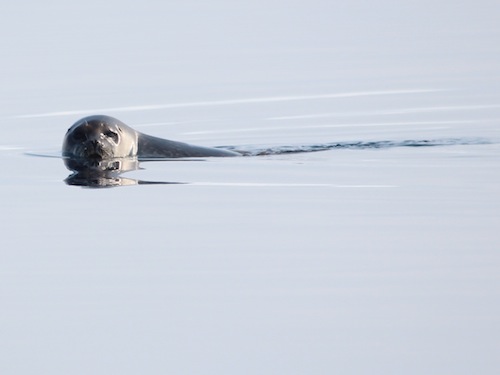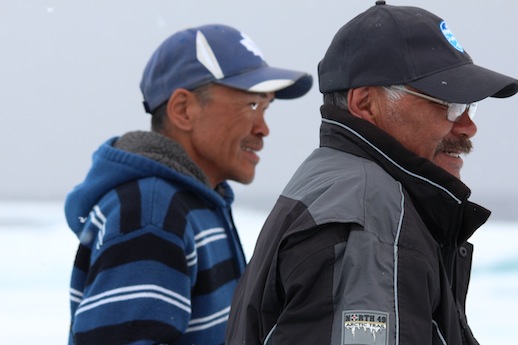Where We Are Today
On the Ice at the Edge of Baffin Bay
|
Kate and I have gotten used to living on the ice now, and the routines have
become our norm. One important consideration is keeping our socks and gloves
dry to keep our feet and hands warm. We work hard not to track snow and ice
into our yurt. There is a mat just inside the door where we take off our boots
to leave their moisture right there. And we make sure to have our inside shoes
within grabbing distance, as you learn quickly that you don’t want to walk
barefoot on that floor; it’s not much different from walking directly on
the ice. Because of the demarcation between the wet area and the dry area and
the difficulty of taking off and putting on our boots once we’re layered
up for the day, we’ve learned to stow everything we might want during the
day within grabbing distance of the mat. If either of us knows she’s
going to have to cross the invisible barrier into the dry region, she asks the
other whether there’s anything she’d like fetched. Socks and gloves
are hung about the interior of the yurt to dry overnight. It’s an
especial pleasure to put on socks and gloves that have been warming on the table
in front of the heater, which we usually have on for half an hour when we get up
in the morning.
I’ve worked out just what I need to wear to stay warm but not overheat. The layers I’m typically wearing are three sets of silk long underwear, one set of woolen long underwear, a sweatshirt, and a cross-country ski suit under the rented pants and parka. In addition, I need one pair of silk sock liners, one pair of woolen sock liners, and one or two pairs of heavy wool socks under the Arctic rubber boots. To keep my head warm, I use a woolen cap, the hood of the ski outfit, and the hood of the heavy parka. For my hands, three pairs of silk glove liners and one pair of medium-weight gloves leave me able to use my binocular and camera without getting cold. The other thing we all try to avoid is unzipping our parkas. Getting the zipper started to zip the parkas up again is such a pain, especially as I can’t usually see it over my binocular. Emma and I have become “zipper buddies” and do one another up several times a day. |
| In the little cove in the ice near our usual position at the floe edge, Long-tailed Ducks sat on the water. We could see “ice blink” on the clouds; the underside of the clouds glowed white where they were above ice, but remained grey where they were over open water. (This can be useful when navigating through the icy sea.) |
|
Long-tailed Ducks |
Ice blink |
| The water was smooth, so the seeing was good. We spent the day standing watch and got many seals and birds (including a single male Northern Pintail), but no Narwhals at all. Emma was almost always on duty as our hydrophone monitor. She continued to report hearing Bearded Seals and Bowhead Whales, as well as the occasional clacking sound of Walruses, but never a Narwhal. |
 Curious Ringed Seal (Photo courtesy of Ryan and Elaine) |
Emma on hydrophone duty |
| Meanwhile, back in camp, Katie, Philip, and Sam Omik (one of the Inuit guides) were readying a special treat for us: |
 Katie, Philip, and Sam preparing to bring us lunch (Photo courtesy of John Chapman) |
| Mark had given us all the opportunity to listen to the hydrophone while others were walking around on the ice, so we knew just how loud our footsteps sound to any creature under the water. We weren’t surprised then when he decreed that we’d spend two hours of the afternoon seated further back from the edge and not speaking and not walking about, in the hope that the Narwhals might come if we didn’t scare them off with our noise. I found this very peaceful. Unfortunately, it didn’t work at all. Not only did we have no Narwhals, there seemed even to be fewer birds. We did whisper to one another to call out the Black Guillemots and the Thayer’s Gull, and we still enjoyed and photographed the streams of King Eiders. |
 Black Guillemot (Photo courtesy of Wikimedia Commons) |
 Thayer’s Gull (Photo courtesy of Wikimedia Commons) |
| Four of us stayed out at the floe edge until midnight ever hopeful, but we saw no more Narwhals. When Sam came out to guard us against Polar Bears, he snapped a photo of us. He explained that the reason we have so many Glaucous Gulls always in one area of the ice floe off in the distance is that his father, who manages the CBC camp, asked him to kill a couple of Ringed Seals to feed his dog team and that’s where Sam butchered them. (Ringed Seals seem to be the convenience stores of the High Arctic.) |
 Sam Omik and Peter Oolateeta (Photo courtesy of Ryan and Elaine) |
 (Photo courtesy of Samuel Omik, Jr.) |
